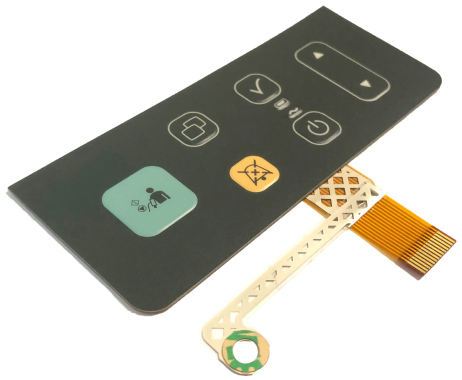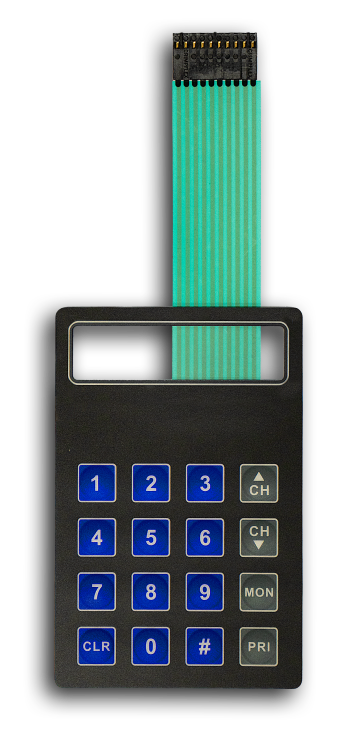Expert Design & Full-Scale Manufacturing
A membrane switch is an electrical device that turns a circuit on and off. Membrane switches, or keypads, are constructed of flexible layers, called membranes, over a printed circuit. Because of their flexibility, membrane switches are found in various industries including medical, industrial controls, consumer electronics, and more.
Membrane switches are considered “momentary action” switches. Simply, this means that the circuits are always open, but by pressing a button on the outer layer of the membrane switch, the printed circuitry is then momentarily closed until the pressure is released.
A membrane switch has a similar function to a mechanical switch. A mechanical switch turns a circuit on or off with a traditional toggle that is normally constructed from metal or plastic parts. Membrane switches are more cost-effective and take up less design space than mechanical switches or buttons because of their low profile. A membrane switch can also fulfill numerous functions of a touch screen, but with fewer circuits and voltage requirements. Membrane switches are the ideal solution because they are convenient, inexpensive, and portable.


Membrane switches are keypads, keyboards, rubber keypads, or display controls outside of touch screens or mechanical switches.
There is no difference between a membrane switch and a membrane keypad other than the moniker.

Tactile vs. Non-Tactile Membrane Switch
Learn more about the differences here.
Download our Design Guide
Download NowSilicone rubber keypads can be integrated with membrane switches, flexible circuits, or printed circuit boards, and have exceptional resistance to extreme temperatures and aging. Silicone keypads are manufactured from elastic silicone rubber compounds. Delivering a user interface with robust environmental protection and excellent tactile response, silicone rubber buttons can be considered for several applications.
Membrane switches offer several advantages over mechanical switches including:
Because of their sealed outer surface and with no perforations required for the membranes to interact, membrane keypads are easy to clean and resistant to harsh chemicals. They are also devoid of crevices where dirt and bacteria thrive in a traditional mechanical switch, making them easy to wipe down and sterilize.
The components of a membrane switch are tiny compared to their mechanical counterparts. Membrane switches are extremely portable and easy to incorporate into product designs, even if available touchpad space is limited.
Compared to touch screens, membrane keypads are more accessible to users with disabilities or those working in environments that require gloves because the keypad offers tactile feedback.
With a flat surface to work with, the sky is the limit for creativity and artistry in your product design. The top layer of the membrane switch can be customized with your brand colors, images, and messaging.
Compared to mechanical switches and touch screens, membrane switches are the most affordable. They are simple to design and can be manufactured from abundant materials.
With all the different customization options and use cases, it might seem overwhelming.
Contact our expert team today and take the pressure off yourself.